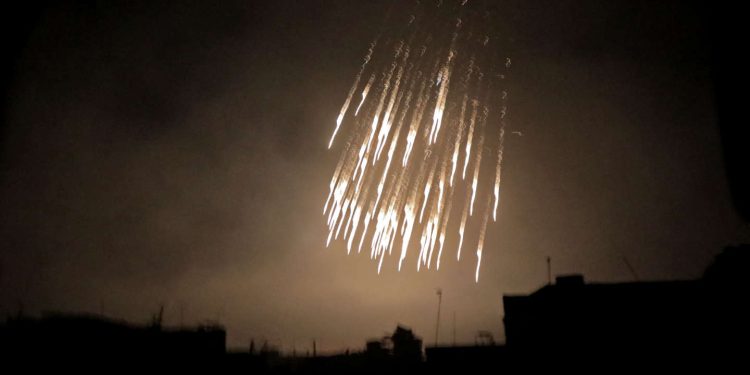BEHDINAN – HPG-BİM made a written statement and provided information on the attacks of the Turkish state and the actions organized by the guerrilla.
HPG-BİM said, “As a result of the actions carried out under the leadership of our YJA Star mobile teams; 3 invaders were punished. These actions were carried out to avenge our comrade Bêrîvan Zîlan, one of the leading commanders of the Free Women’s Movement.”
The statement continued: “The invading Turkish army defines the Resistance Areas; It bombed 34 times with phosphorus bombs, tactical nuclear bombs and chemical weapons, 13 times with attack helicopters, 7 times with warplanes, and dozens of times with tanks and howitzers. The invading Turkish army bombed the battle positions in the Şikefta Birîndara Resistance Area once with tactical nuclear bombs and 26 times with phosphorus bombs, while the war positions in the Çemço, Saca, Girê Amediyê and Girê Cûdî Resistance Areas were bombed 7 times with tactical nuclear bombs and chemical weapons.”
HPG-BİM gave the following details regarding the guerrilla actions and the attacks of the invading state:
1. In the Zap region as part of the Bazên Zagrosê Revolutionary Campaign;
- On August 21, at 23:00, the helicopters that wanted to bomb the Çemço Resistance Area were shot down by our mobile teams. After the intervention of our forces, the helicopters had to leave the area.
2. Within the framework of the Cenga Xabûre Martyr War Maraş Revolutionary Campaign;
- On August 21, at 16:15, the invaders in the Girê Cûdî Resistance Area were hit and beaten.
- On August 21, at 18:10, the invaders in the Girê Hakkarî Resistance Area were shot by our YJA Star moving teams with an assassination tactic and 1 invader was punished.
- Between 20:30 and 21:30 on August 21, the invaders in the Girê Amediyê Resistance Area were shot twice by our YJA Star moving teams with an assassination tactic, and 2 invaders were punished.
3. The attacks carried out by the invading Turkish army with tactical nuclear bombs and chemical weapons;
- On 21 August, the battle positions in the Şikefta Birîndara Resistance Area were bombed 26 times with phosphorus bombs.
- On 21 August, the battle positions in Şikefta Birîndara, Çemço, Saca, Girê Amediyê and Girê Cûdî Resistance Areas were bombed 8 times with tactical nuclear bombs and chemical weapons.
4. The attacks carried out by the invading Turkish army with howitzers, heavy weapons and helicopters;
- On August 21, drone activity was observed in Girê Cûdî and Girê FM Resistance Areas.
- On 21 August, Çemço, Girê Hakkarî, Girê Amediyê, Girê Cûdî and Girê FM Resistance Areas were bombed 13 times with attack helicopters.
- On 21 August, the Girê Hakkarî, Sîda and Çemço Resistance Areas were bombed 7 times with warplanes.
- On August 21, Şikefta Birîndara, Girê Hakkarî and Girê Amediyê Resistance Areas were bombed dozens of times with howitzers and heavy weapons.”
THE USE OF CHEMICALS IN ROJAVA
Wessling Laboratory in Switzerland has revealed an abnormal presence of the white phosphorous on a sample of the skin of a Kurdish fighter, who was wounded in the Turkish attack on the town of Sere-Kaniye (Ras Al-Ain), north-eastern Syria in 2019.

Al-Nahar newspaper in a report published indicated that the Autonomous Administration of north-eastern Syria has presented the analyzes of the Swiss laboratory in Paris, confirming the Turkish military used phosphorous bombs in their military attack on north-eastern Syria, last October 2019.
The report concluded: “The type of injury (chemical burns), in addition to the very high amount of phosphorous in the sample, proves that phosphorous (white phosphorous munitions) was used,” according to al-Nahar newspaper.
The newspaper pointed out that doctor Abbas Mansouran, who treated the victims of the Turkish bombardment, confirmed that some of the unusual burns are due to the use of unconventional weapons.
Dr. Abbas also confirmed during a press conference in Paris, along with the spokesperson for the People’s Protection Units YPG, Nuri Mahmoud and the representative of the Autonomous Administration of north-eastern Syria, Khaled Issa, that “the injuries and symptoms that appeared on the victims, most of them were civilians, are consistent with exposure to chemical weapons.”
The Autonomous Administration of north-eastern Syria had accused Turkey of using internationally prohibited weapons such as napalm and white phosphorous in its military invasion in Ras al-Ain, the administration called for opening “an international and official investigation into these violations.”
The Autonomous Administration confirmed that Turkey targeted more than 30 unarmed civilians, including children, with these internationally prohibited weapons.
Dr. Jiwan Mustafa, the co-chair of the Health Authority in al-Jazira region, north-eastern Syria, had previously confirmed in a special statement to North-Press, that “all cases confirm that chemical weapons were used in the Turkish attack on Sere-Kaniye (Ras Al-Ain), specifically in the areas of Aliya and its silos on the 13th of last October, all injuries indicate that Turkey used the white phosphorous.”




